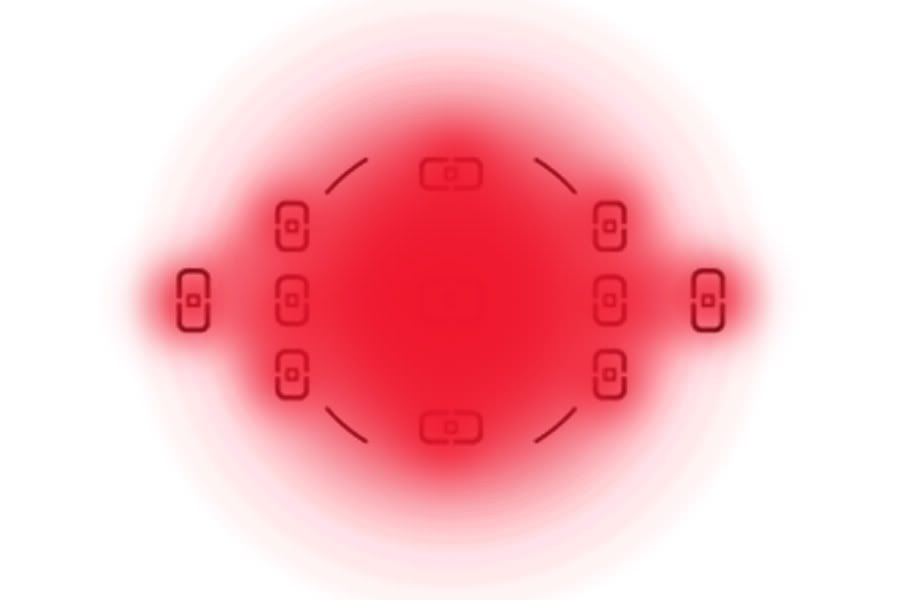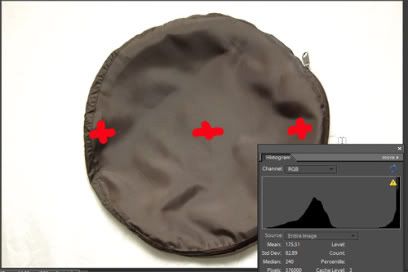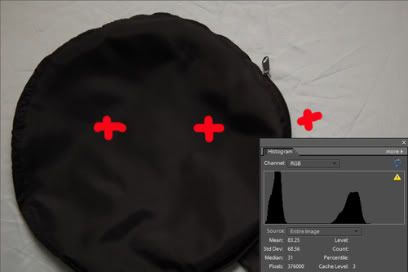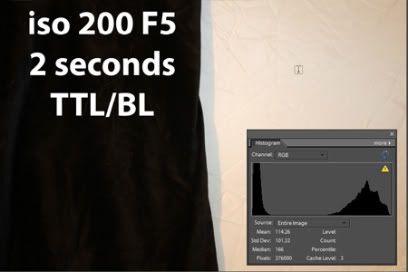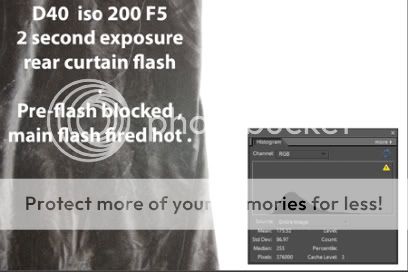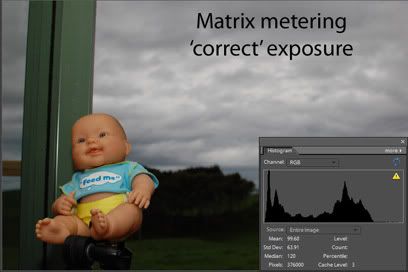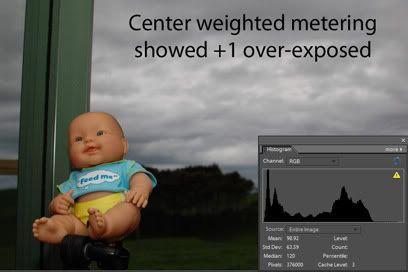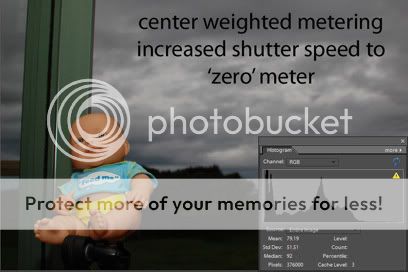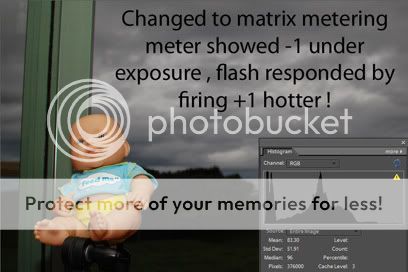As of 7 July 2010 I am inviting test shots from Canon users to try to 'reverse engineer ' Canon's flash system in a similar way to what I did with Nikon TTL-BL mode .
So far Stefan on photocamel has provided me with these images from the 7D and a 430 EX flash and the results are interesting .
Test 1.)
The histograms of both the 'near' focus and 'far' focus both went down instead of the 'far' focus increasing exposure as with TTL-BL mode . I was expecting the distance info from the lens to tell the flash system to increase output when the focus was changed to infinity but the opposite happened ?
Perhaps when the camera doesn't detect anything in focus it reverts to plain "average gray" metering for the flash ?
Now we are in the really early stages of doing these tests and nothing has been double checked by others yet so I still welcome input . I would like to go through all the tests as shown in my TTL-BL blog to see what we can work out and compare Canon and Nikon flash systems just for interest and for those who would like to learn the 'nuts and bolts' of the systems .
This is how Nikon's TTL-BL handled the situation .
When the flash system detected that focus distance was at its maximum it increased exposure without showing too much regard for the out of focus white in the foreground .
Compared to what Canon ETTLii does for the moment I see this as an advantage .
There are probably very few people who use manual focus indoors but for anyone who does manually select a focus distance the Canon flash system will instantly lose any advantage distance information from the lens would have given it if the camera doesn't agree that anything is in focus .
However with the run of problems with canon auto-focus who know what the camera may deem to be 'in-focus' ;) .
So the question now is " Does Canon ETTLii totally drop the distance information when it doesn't detect 'focus confirmation ?"
Anyone interested in doing the tests , this is the scenario we need :
Test 2.)
Please excuse the creepy looking baby but "Stinky" was my model back then .
Have a white object close to the camera and covering half the frame . Place the subject next to the reflector , take a picture , and then quite a distance behind it and take some pictures .
Nikon's TTL-BL ignored the white object and concentrated on what was in focus at the right distance .
Then set focus on infinity and take another picture .
This will tell us if ETTLii uses the lens distance info when the subject is in focus and whether it totally drops it if it does not confirm focus on a distance object .
I'll list the tests I would like samples of for those interested in participating , we'll call this test number 3.)
A comparison between TTL and ETTLii with a black and white subject and varying degrees of 'centrality' of the subject .... like this ....
The point of this test is to show how TTL meters differently to ETTLii . Normal TTL meters off a central circle while ETTLii should meter almost equally for the white subject as long as part of it is under the focus points . if the white leaves the focus point 'diamond' then it will probably blow out .
The metering pattern sits under the focus points and , if it can select the size of the subject it meters off like TTL-BL , should give reasonably consistent results compared to TTL flash .
Another way of doing this test is with a black circle on a white background ... my D40 has 3 focus points .
As you can see the focus point diamond plays a very important role in how TTL-Bl meters .... how does canon flash compare ?
Test 4.) A basic test that should give the same results in TTL and ETTLii mode .
Take a picture indoors where it is dark . iso 100 , F16 and 2 seconds [ the ambient must still be underexposed ] , use rear-curtain flash . Put your hand in front of the flash and take the picture - as you press the shutter the pre-flash will fire on your hand ..... move your hand away before the main flash fires - just before the shutter closes .... it should fire brighter than normal since it couldn't detect the pre-flash reading .
Something like this ......
Test 5.) This is where it gets a little more complicated .
Set up your camera in manual on a tripod [ as you should have been doing ] . Take a picture of a subject with the ambient under-exposed by 4 stops using TTL mode and then in ETTLii mode .
they should look similar .
Then with the camera in manual mode still find the point where the meter shows correct exposure .
Take another picture in TTL mode and ETTLii mode . Most likely the picture in TTL mode will be much brighter than ETTLii which should register the fact that you have the ambient correctly exposed and compensate by backing off the flash .
Test 6.) [Similar to test 5 ] Slightly more complicated .
Find a situation where CW metering and pattern metering give different readings - look at the following images ....
What we are trying to do in this test is establish how ETTLii decides how well you have the ambient metered . With TTL-BL the evidence suggests that TTL-BL is 'watching the meter ' and as soon as the meter moves to show underexposure the flash output increases to compensate - even if the the settings haven't changed !
I was told that TTL-BL measures the 'RAW data' to determine what the lighting is like .... obviously this can't be the way it does it because regardless of what the light looks like the final exposure depends on the settings you have chosen and how you decide to expose the image .
So : Find a setting similar to my example where CW and Pattern metering give different readings . Set the camera so you are correctly exposed for the one mode and when you change to the other mode you get under-exposure [ according to the meter ] . Take a picture with ETTLii at 'correct' exposure and then simply switch to the other exposure mode , that tells you it is now underexposed , and without changing any other settings take another picture with ETTLii and see if the output has changed .
These images were submitted recently - both taken with a lens that does not provide distance information ....
The histograms are almost identical showing that the flash output was the same even though the focus distance changed - obviously ETTLii couldn't use distance info in the equation .
There was a difference in the images when manual focus was used and the camera did not confirm a focus-lock .... it then appears to simply expose for average gray on the brightest object in the scene .
So far Stefan on photocamel has provided me with these images from the 7D and a 430 EX flash and the results are interesting .
Test 1.)
The histograms of both the 'near' focus and 'far' focus both went down instead of the 'far' focus increasing exposure as with TTL-BL mode . I was expecting the distance info from the lens to tell the flash system to increase output when the focus was changed to infinity but the opposite happened ?
Perhaps when the camera doesn't detect anything in focus it reverts to plain "average gray" metering for the flash ?
Now we are in the really early stages of doing these tests and nothing has been double checked by others yet so I still welcome input . I would like to go through all the tests as shown in my TTL-BL blog to see what we can work out and compare Canon and Nikon flash systems just for interest and for those who would like to learn the 'nuts and bolts' of the systems .
This is how Nikon's TTL-BL handled the situation .
When the flash system detected that focus distance was at its maximum it increased exposure without showing too much regard for the out of focus white in the foreground .
Compared to what Canon ETTLii does for the moment I see this as an advantage .
There are probably very few people who use manual focus indoors but for anyone who does manually select a focus distance the Canon flash system will instantly lose any advantage distance information from the lens would have given it if the camera doesn't agree that anything is in focus .
However with the run of problems with canon auto-focus who know what the camera may deem to be 'in-focus' ;) .
So the question now is " Does Canon ETTLii totally drop the distance information when it doesn't detect 'focus confirmation ?"
Anyone interested in doing the tests , this is the scenario we need :
Test 2.)
Please excuse the creepy looking baby but "Stinky" was my model back then .
Have a white object close to the camera and covering half the frame . Place the subject next to the reflector , take a picture , and then quite a distance behind it and take some pictures .
Nikon's TTL-BL ignored the white object and concentrated on what was in focus at the right distance .
Then set focus on infinity and take another picture .
This will tell us if ETTLii uses the lens distance info when the subject is in focus and whether it totally drops it if it does not confirm focus on a distance object .
I'll list the tests I would like samples of for those interested in participating , we'll call this test number 3.)
A comparison between TTL and ETTLii with a black and white subject and varying degrees of 'centrality' of the subject .... like this ....
The point of this test is to show how TTL meters differently to ETTLii . Normal TTL meters off a central circle while ETTLii should meter almost equally for the white subject as long as part of it is under the focus points . if the white leaves the focus point 'diamond' then it will probably blow out .
The metering pattern sits under the focus points and , if it can select the size of the subject it meters off like TTL-BL , should give reasonably consistent results compared to TTL flash .
Another way of doing this test is with a black circle on a white background ... my D40 has 3 focus points .
As you can see the focus point diamond plays a very important role in how TTL-Bl meters .... how does canon flash compare ?
Test 4.) A basic test that should give the same results in TTL and ETTLii mode .
Take a picture indoors where it is dark . iso 100 , F16 and 2 seconds [ the ambient must still be underexposed ] , use rear-curtain flash . Put your hand in front of the flash and take the picture - as you press the shutter the pre-flash will fire on your hand ..... move your hand away before the main flash fires - just before the shutter closes .... it should fire brighter than normal since it couldn't detect the pre-flash reading .
Something like this ......
Test 5.) This is where it gets a little more complicated .
Set up your camera in manual on a tripod [ as you should have been doing ] . Take a picture of a subject with the ambient under-exposed by 4 stops using TTL mode and then in ETTLii mode .
they should look similar .
Then with the camera in manual mode still find the point where the meter shows correct exposure .
Take another picture in TTL mode and ETTLii mode . Most likely the picture in TTL mode will be much brighter than ETTLii which should register the fact that you have the ambient correctly exposed and compensate by backing off the flash .
Test 6.) [Similar to test 5 ] Slightly more complicated .
Find a situation where CW metering and pattern metering give different readings - look at the following images ....
What we are trying to do in this test is establish how ETTLii decides how well you have the ambient metered . With TTL-BL the evidence suggests that TTL-BL is 'watching the meter ' and as soon as the meter moves to show underexposure the flash output increases to compensate - even if the the settings haven't changed !
I was told that TTL-BL measures the 'RAW data' to determine what the lighting is like .... obviously this can't be the way it does it because regardless of what the light looks like the final exposure depends on the settings you have chosen and how you decide to expose the image .
So : Find a setting similar to my example where CW and Pattern metering give different readings . Set the camera so you are correctly exposed for the one mode and when you change to the other mode you get under-exposure [ according to the meter ] . Take a picture with ETTLii at 'correct' exposure and then simply switch to the other exposure mode , that tells you it is now underexposed , and without changing any other settings take another picture with ETTLii and see if the output has changed .
These images were submitted recently - both taken with a lens that does not provide distance information ....
The histograms are almost identical showing that the flash output was the same even though the focus distance changed - obviously ETTLii couldn't use distance info in the equation .
There was a difference in the images when manual focus was used and the camera did not confirm a focus-lock .... it then appears to simply expose for average gray on the brightest object in the scene .














